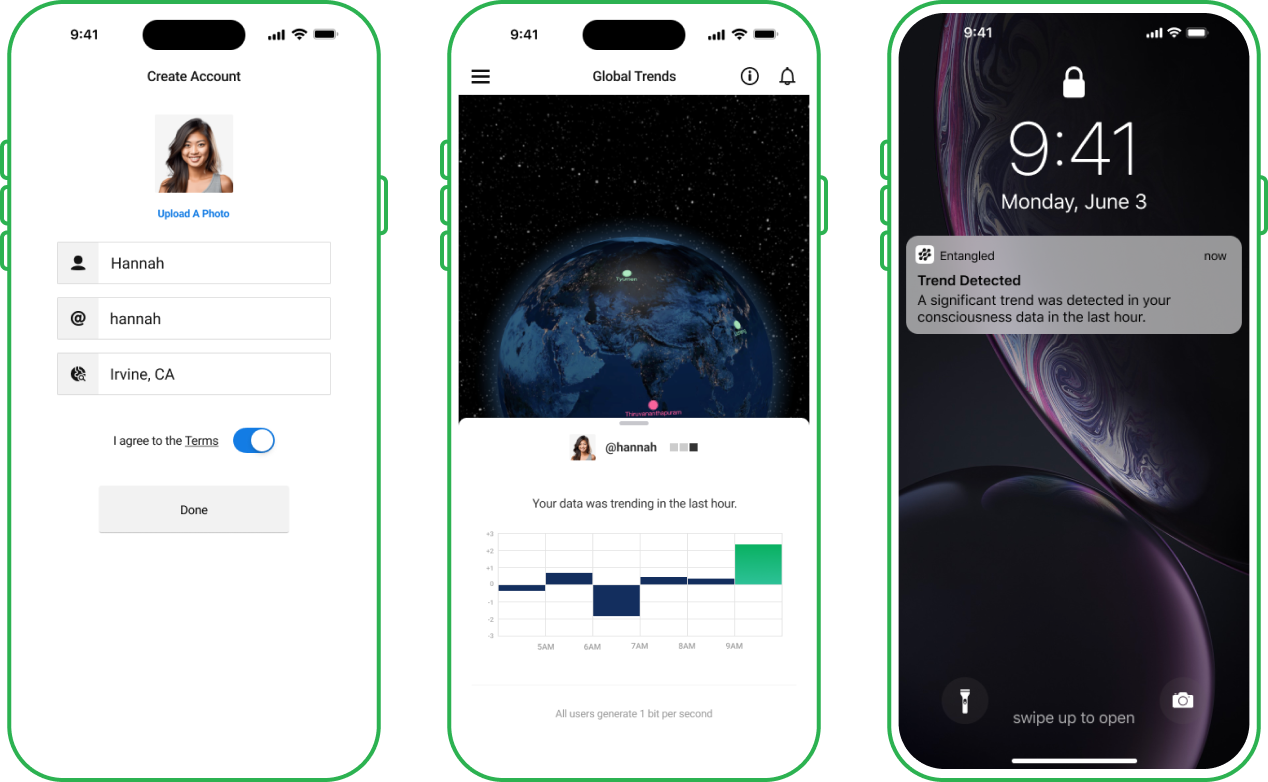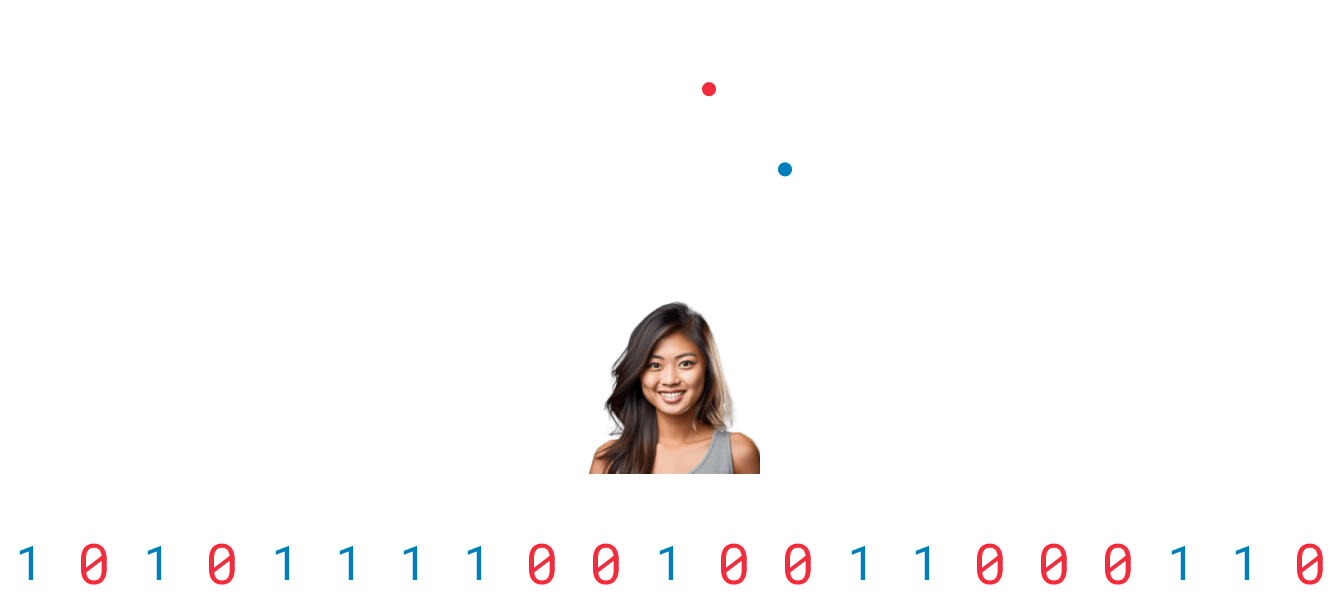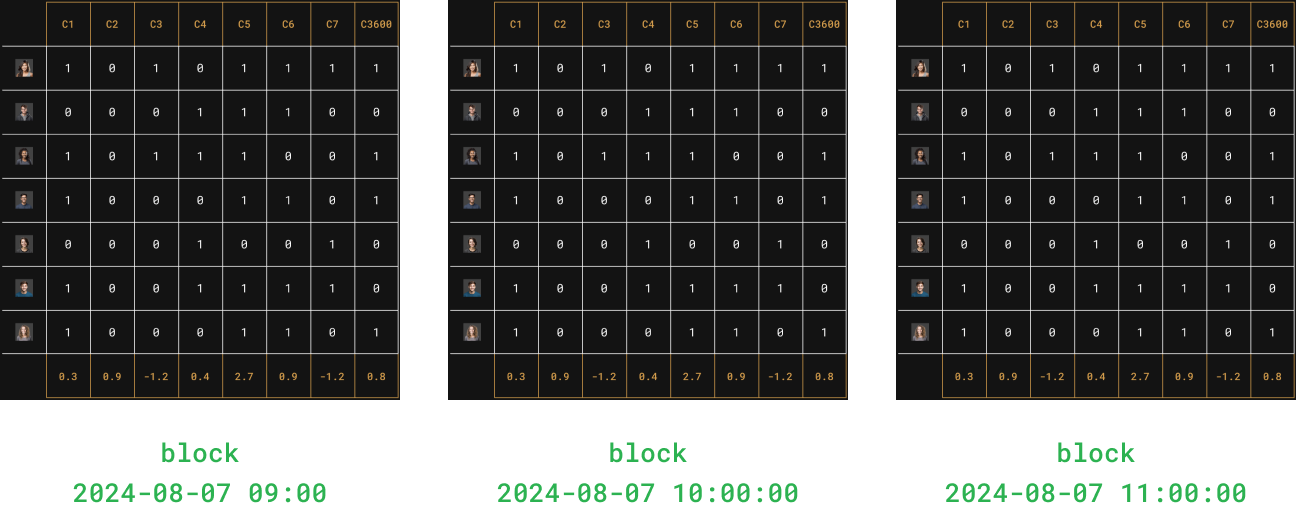Entangled
Entangled is an exploration of the role of consciousness in the Universe, and the possibility of
accessing information across time and space by tapping into it. Entangled consists of a mobile app connected
to quantum hardware, which follows a set of rules called the Entangled Protocol.
The app allows anyone in the world to join. The quantum hardware looks for consciousness (psi) effects, and the
Protocol allows thousands of experiments to run on the network.
export hidden knowledge
Core Assumptions
Entangled is based on a few core assumptions. While controversial, they are backed by scientific evidence. References here.
1. Consciousness can access information across time and space
Our conscious mind is only the tip of the iceberg. Deeper parts of our mind in the realm of our subconscious
contain or can access knowledge not available to the conscious mind. Intuition, gut feelings, inner guidance,
precognitive dreams, and remote viewing are common examples. Laboratory investigations have convincingly
demonstrated the ability of human cognition to anticipate future events, such as randomized stimuli.
In evolutionary terms, accessing information across time and space is an adaptive advantage. These
capabilities make sense if our brains are entangled to the fabric of the cosmos as new research suggests, or
if the Universe is holographic, or if we live in some kind of advanced Simulation operated by our
consciousness.
The question is how to tap into it.
2. Consciousness can influence the behavior of quantum systems
Mind-matter interaction at the quantum level is an established but poorly understood phenomenon. The effects
are statistical. Examples include Princeton’s studies correlating the output of quantum RNGs with human
intention and the Institute of Noetic Science’s experiments in remote photon influence. Cumulative
results from these labs exceed chance by millions to 1, and are substantiated in meta analysis.
The mechanism of influence remains unknown. It does not necessarily involve observer effect interpretations in
QM. Future developments in quantum biology, physics, Simulation theory, etc, will provide a mechanism to
explain these data.
3. The subconscious is the driver
Broadly speaking, the subconscious contains or can access information distant in time and space, and is also the agent that influences the quantum systems. No conscious effort is required.
From this we construct the core concept:
There are questions which are difficult or impossible to answer without traversing time and space. While we can’t physically do this, our consciousness by its nature can. Entangled structures these questions to enable the subconscious minds of its users to ‘vote’ on answers by flipping photon bits in quantum hardware, according to what the subconscious knows or acquires through time and space. Bits are collected and turned into an answer.
Questions can be any input that would benefit from hidden knowledge. Answers are output as statistical outcomes, which provide results to experiments running on the network.
The Mobile App
Downloading the Entangled app and creating an account is all you need to do. This connects your account to a
quantum hardware node. The hardware dedicates a continuous stream of photon bits to you, which are collected
and analyzed hourly, following the Protocol (more on this below).
This setup enables your subconscious mind to influence the photons, and associate the results with experiments
running on the network.

The app provides feedback on your consciousness effects in the form of interactive visualizations, charts, and
push notifications.
It can also display consciousness effect trends in your city and across the globe, and provide push
notifications for these too.
Finally the app allows you to explore the current experiments and applications running on the network, and be
notified of interesting results.
Quantum Hardware
Consciousness effects are statistical. They are quantified by comparing observed outcomes to those expected by
chance, or assessing how much a particular data sample differs from theoretical predictions.
Photons (particles of light) are perfect for this, because they follow simple principles described in quantum
mechanics that provide perfect theoretical predictions against which consciousness effects can be measured.
Entangled uses specialized hardware that converts photon behavior into data, enabling the potential influence
and quantification of a user’s subconscious mind.

Within each hardware node is a light source that sends photons to a beamsplitter, which is a semi-transparent
mirror at a 45º angle. Each photon will either travel through the beamsplitter to a detector, or be reflected
by it into a separate detector.
Photons are converted to bits (1 or 0) depending on which detector they reached. According to quantum optics,
the path of the photon is intrinsically random. Therefore each bit has an equal probability of being a 1 or 0
(p=0.5). This greatly simplifies the statistics used to look for consciousness effects in the Entangled
network.

Hardware nodes can be scaled to handle millions of photons per second. Each node passes the NIST SP800-22 compliance tests for randomness.
The Protocol
The Entangled Protocol is a set of rules which provide answers to questions associated with experiments running on the network by governing the interaction between users and hardware, and data structures called channels and blocks.
Users
A user is anyone with an account, created in the mobile app. Accounts are connected to a hardware node that
produces photon bits at a rate of 1/second/user. Each user has a dedicated stream of bits, just for them.

Bits are collected and analyzed hourly. There are 3600 seconds in an hour, so each user
‘contributes’ 3600 bits/hour. In statistical terms, this is called a trial. Each trial is analyzed
to produce a single number, called a z-score.
The z-score is the distance from the mean in terms of standard deviations. In each trial the Number of bits
(n) is 3600, the Probability (p) of each bit being a 1 is 0.5, the Mean (n*p) is 1800, and the Standard
Deviation (σ) is 30. Z = x−μ/σ, where x is the sum of the user’s bits for that trial.
For example, a bit sum of 1880 is z= 2.6. A bit sum of 1772 is z= -0.93. There is nothing innately good or bad
about a positive or negative z, it is just how the balance of 1s and 0s are represented.
Consciousness effects show up in the z-score. Scores above 2 are significant, and scores above 3 are more
significant. Significance can be attributed to random chance or to the user’s subconscious influence on
the photons, or both. As always, correlation is not necessarily causation.
The mobile app uses z-scores to drive visualizations, charts, and push notifications for users in the mobile
app. They are also used in channels, which are how questions are posed to the network.
Channels
Channels are the structure that enable answers to be contributed by the subconscious minds of all users
simultaneously. If users are rows, channels are the columns.

Imagine a giant spreadsheet. Every user is a row, and there are 3600 hundred columns representing the 3600
photon bits they will receive during that hour trial. Now imagine the first bit goes into channel 1, the
second bit to channel 2, and so on, until all 3600 channels are filled.
In this way, questions posed to the network by experiments can be assigned to channels. The
subconscious minds of the network can ‘vote’ on each question by flipping photon bits in those
channels, producing an answer in the form of a channel z-score. The experiment or app makes the z-score
meaningful.
For example, a channel z-score of 2.1 might imply a weak ‘yes’ while a score of -3.8 might imply a
strong ‘no’. Lesser scores would be ignored.
When the hour trial ends, channel z-scores are saved in file called the block file.
Blocks
Blocks are the final product of the Protocol. They are large JSON files that document the results for each
channel and any questions that were assigned to them. 24 blocks are produced each day.

Experiments and Applications
Experiments and apps are essentially forms of questions posed to the network which interpret z-scores as
meaningful answers. Questions can take many forms. Several types of answers can be constructed from a z-score,
such as binary results or constraining a search space. Magnitude or confidence can be implied from the score.
The Earthquake Prediction experiment provides an example of how an answer can be constructed from a channel
z-score.
We want to know if an earthquake of magnitude 5.0+ will impact Tokyo in the next 24 hours. This is unknowable
with current instrumentation, but might be known or retrievable across time by the subconscious minds of
Entangled users.
We formulate a question with defined success criteria and assign it to a channel:
With each new block file, the experiment monitors channel 127 for z-scores exceeding 3.0, which would indicate a collective subconscious prediction. If the criteria is met, the prediction is registered and subscribing users may be notified. Actual earthquake activity is monitored via the USGS API. If an earthquake does happen that meets the predefined criteria, it’s counted as a success. With enough events, some sense of accuracy can be known.
What comes after AI?
A superintelligence is anything that greatly exceeds the capabilities of a human being. Artificial
intelligence is the common example. AI will exceed most capabilities of humans and do incredible things. But
it is only as good as the data to which it has access, and how it is used in the world.
Entangled, if successful, may represent a new kind of superintelligence, one not based on big data and
supercomputers, but instead imbued with the capability of accessing non-local information and hidden knowledge
available only to consciousness itself, and whatever innate wisdom and guidance may be acting through it.